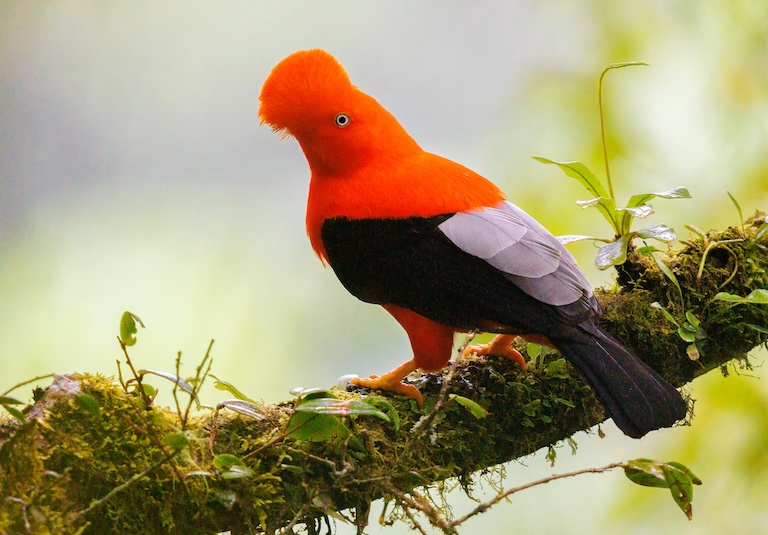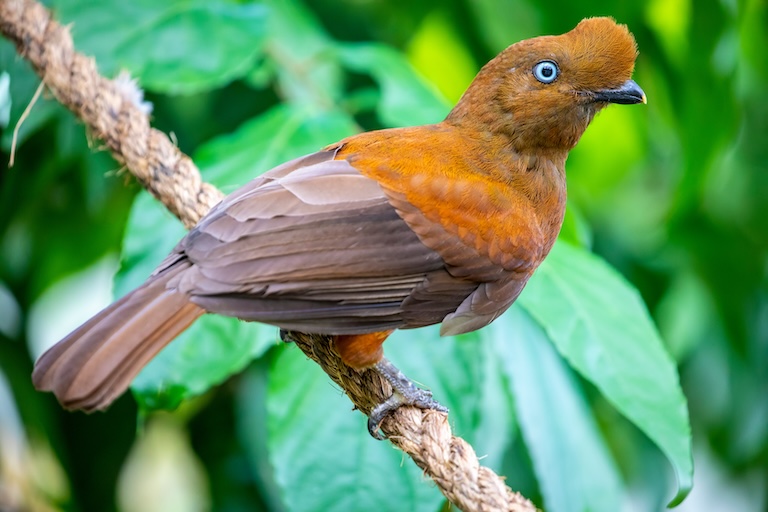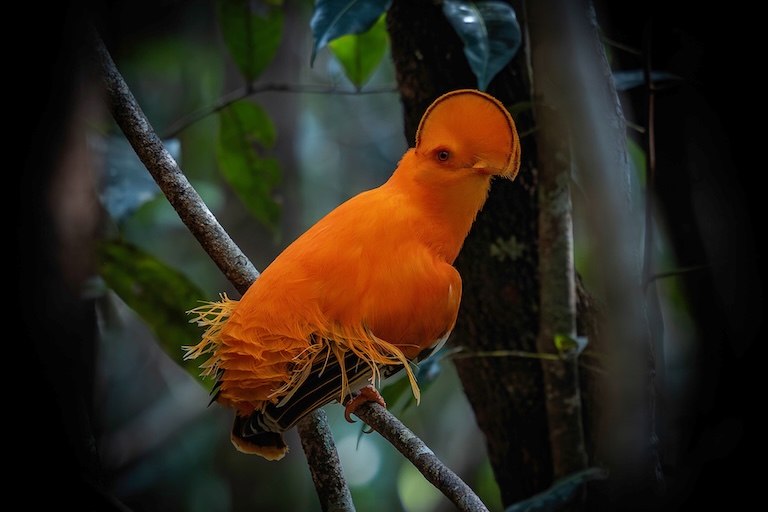Cock-of-the-Rock Profile
Central and South America is well known for its unique and diverse bird life. Even in prehistoric times, some of the strangest avians to have ever lived spent their existence in that part of the world.
Today, the “Bird continent” of South America has over 3400 species, and among them, the Cotingidae family, known for their bright colours and strange behaviour is one of the most populous.
One small group of birds within them truly live up to the reputation with a bulbous crested face and a Mick Jagger attitude that’s earned them the nickname cock-of-the-rock.

Cock-of-the-Rock Facts Overview
| Habitat: | Mountainous cloud forests |
| Location: | South America |
| Lifespan: | 7 years in captivity |
| Size: | 30cm (12 inch) tall, 18cm (7 inch) wingspan |
| Weight: | 200g (7oz) |
| Colour: | Bright orange or red |
| Diet: | Mostly fruit, also insects, amphibians, reptiles, sometimes mice |
| Predators: | Raptors, jaguars, mountain lions, ocelots, snakes |
| Top Speed: | Unknown |
| No. of Species: | 2 |
| Conservation Status: | Least Concern (IUCN) |
Like so many in their family, these funny-looking birds are expert dancers, capable of pulling off dazzling displays of sound and colour.
The crest on the male cock-of-the-rock covers so much of the front of its face that the beak is sometimes totally obscured. This gives the bird a sort of beluga-like lump for a head, but the women dig it, and they, too, have a similar protrusion on their faces.
The two species are separated by some distance, and easy to tell apart, and both are listed as of Least Concern by the IUCN, despite widespread deforestation.
Interesting Cock-of-the-Rock Facts
1. They’re cotingas
Cotingas are a large family of songbirds from Central and South America, and they’re not known for their subtlety. One of the loudest animals on Earth, the white bellbird, is a member of this family, as are such classics as the screaming piha and the long-wattled umbreallbird.
Cotingas are notorious for showing off, and in species in which the females are the only ones who care for the eggs, the males invest their energy into well-choreographed and elaborate courtship displays.
Some do these in the trees, others, like the cock of the rock, are more down to earth. 1
2. Females aren’t as pretty
as is often the case with birds, sexual selection has let the responsibility of looking good to the males, and the cock of the rock is no exception. The males are very glamorous, brightly-coloured birds with a bulbous feathery crest that is apparently irresistible to the relatively dull-looking females.
But they’re not as plain as some other species. In the plumage of the females, you can see a little touch of the magic the males are rocking, sporting a reduced crest and some more subtle colouration in her feathers.
This is a very easy bird to recognise, both in the male and female, as nothing else really looks anything like it. Of the two species, the Guinean is lighter, and they look somewhat similar, but even if they lived in the same part of the continent – which they don’t – they’re quite easy to tell apart.

3. They lek
Leks are aggregations of male animals, coming together to compete with one another for females. This mating strategy is commonly seen in antelope, or on a Friday night on Watford Highstreet, and is a bit less common in birds, but happens all across the animal kingdom, even in some species of fly.
A lot of time and effort goes into these displays, and the male cock-of-the-rocks will gather in groups of fifteen or more, all of whom are looking for the best dancing site to show off their goods.
Some appear to pair up or work together to protect their location from other males, and combat on the wing is not unheard of during this event. 2
4. They make a strange noise
Each male finds his own site, which will be roughly a square meter of forest floor. They’ll either occupy this spot or perch on a branch above it, practising their moves and chattering away.
They make an almost talking-like call, rising and falling in pitch, usually with a corresponding wing gesture. This call alerts and attracts the local females, who will nest away from these sites, and only visit to watch the show. 3 4
5. They headbang
When it’s time to perform, the courtship rituals begin with a deafening crowd of vocalisations, followed by a bobbing of the head, a beating of the wings and a period of silence.
Females observe these displays from their position, perched on branches above the arena. If she likes what she sees, she’ll enter his stage and he will greet her with a bow. If this is convincing enough, she’ll stick around and allow mating to go ahead. If not, she’ll leave.
If the male is successful, it’ll be a brief moment of copulation before the female hurries off on her own. 5
6. Females pick the best players
Females have an apparent preference for a wide range of details in the male’s performance. They’re looking for plumage quality, experience and motion, and on the whole, a male who has already mated is of higher value than one who hasn’t.
This is a mating strategy that involves active female choice, and it’s commonly seen that they will ignore lower-ranking males more as the event goes on, being drawn to larger leks with strong male presence.
7. They’re probably important seed dispersers
Aside from their quirky mating habits, these birds play a significant role in their ecosystem as seed dispersers.
They’re generalist frugivores, and while the Andean species is less discriminatory than the Guianan cock-of-the -rock, both eat enough fruit that their poop is riddled with seeds.
By bringing these seeds to lek sites, they have a significant influence on forest dynamics and help regenerate their habitats in the areas in which they breed.

Cock-of-the-Rock Fact-File Summary
Scientific Classification
| Kingdom: | Animalia |
| Phylum: | Chordata |
| Class: | Aves |
| Order: | Passeriniformes |
| Family: | Cotingidae |
| Genus: | Rupicola |
Fact Sources & References
- “Guianan Cock-of-the-rock”, The Cornell Lab of Ornithology.
- Paul Kriedemann (2017), “Cock-of-the-Rock: Lek Watching for Science, Conservation, and Community Development”, Fauna Forever.
- San Diego Zoo (2020), “Cock of the Rock Rocking Out”, YouTube.
- Marek Jackowski Photography (2022), “Andean Cock of the Rock. Lek and nesting.”, YouTube.
- “Rupicola rupicola Guianan cock-of-the-rock”, Animal Diversity Web.
